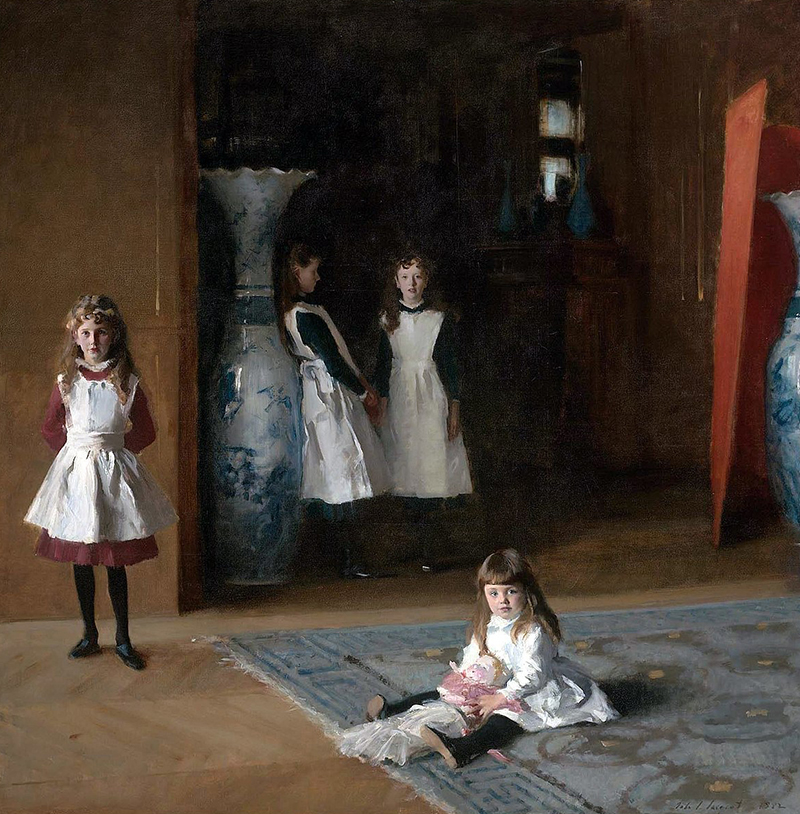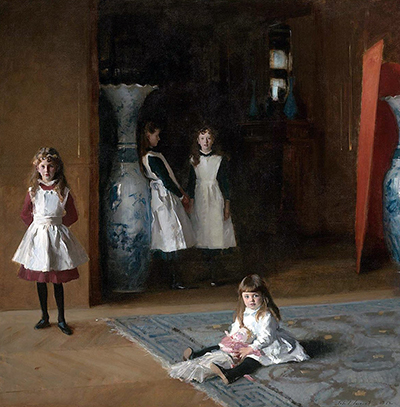The Daughters of Edward Darley Boit painting was one of Sargent's most exceptional works of art
John Singer Sargent's mastery of oil painting was exceptional going by the artwork he produced. His art was a product of his intriguing painting techniques. He regarded painting as an interpretation of expressions through color and brush.
It brought out his rapid and very unique technique. His general procedure for the painting included using a large brush to not starve his palette. He would start by using charcoal to accurately place his masses, then laying half an inch in the background over the border of the bordering tones.
As accurately as possible he would then lay in the mass of hair, bringing the painting into visual context and blending the tones with the background while overlapping the forehead. He would lay in a middle flesh tone for the face and paint a light tone on the left side and a dark one on the shadow side.
He strived to always bring recover the drawing and fusing the flesh into the background with every stroke. His general technique to obtain the desired an exact quality in colour and in tone was painting the flesh into the background and background into flesh.
Sargent's technique was made up of several pointers that he employed in his art and used in the Daughters of Edward Boit painting.
- Painting, colour applied with a brush, is an expression of tone
- He kept the planes free and simple, painting a full brush down the whole boundary of the cheek
- He always painted one part into another and not adjacent to each other, until they blend in together
- He believed in using a thicker paint for more flow of the colours
- A painting can omit all other elements but the essential ones. The values presented in the painting must be clarified
- He believed that it was impossible for a painter to rectify a head of a painting where the understructure was done wrong

Material and Theme of the Painting
The material of the painting was oil on canvas. This was Sargent's favourite medium of painting. It involved painting with pigments that contain drying oil as the binder. The commonly used oils included poppy seed oil and safflower oil.
The type of oil used had an effect on the paint such as the time taken for yellowing or drying the paint. The themes of the Daughters of Edward Boit painting can be carefully examined by examining the contents of the painting.
The painting showed shows four girls of distinct ages in a domestic household. The other most visible aspect of the painting is the large Chinese vases on either side. The other most visible item in the painting is the decorative rug which lies across the room.
Though this painting is generally described as a portrait, the placement of the figures in the painting does not allow emphasis to be put on the girls as a single unit. All the girls are captured in very distinct positions across the painting.
This seems to suggest that the girls are actually not posing to be painted but have been captured by the painter within the spur of the moment. There is a lot that can be read from the painting that does not pertain to the girls, but one cannot ignore the aura created by the painting by the girls.
Each girl seems to be exhibiting her own unique character through her position. Sergeant seems to have observed and understood the individual personalities of these girls and ended up getting a perfect moment to bring out those personalities in a painting.
The painting has been described by art enthusiasts as the most psychologically compelling artwork of Sargent's career. The painting is quite distinct from other paintings that were being done at the time.
Artists Related to the Work of John Singer Sargent
Sargent was brought up in Paris by his parents. He began training and sharpening his painting skills under the tutelage of a popular portrait artist known as Charles Auguste Emile Carolus –Duran. This painter had a tremendous influence on Sargent's technique and approach to painting over a couple of years. Charles imposed on him, his respect for renowned masters such as Anthony van Dyck and Diego Velazquez.
Sargent met American impressionist painter J. Alden Weir in 1874 when he qualified to enter the Ecole des Beaux-Arts, France's leading art school. Weir referred to him as one of the most talented fellows he had ever met. During his time at the art school, Sargent met another painter who would have considerable influence of his artwork. He met portrait painter Paul Cesar, Claude Monet, Auguste Rodin and Edgar Degas. Sargent painted Auguste Rodin in 1884.
Sergeant made his maiden visit to America in 1876 where he staged an exhibition of his artwork in Paris Salons in 1877. His work was immediately received with both critical and popular acclaim. As a result, he embarked on a journey across Europe to meet and make acquaintance with the most renowned and experienced painters at the time.
In 1855 and 1886 he was partly inspired by his relationship with impressionist Claude Monet and began experimenting with painting outdoors to replicate time-specific visual impressions. Monet aided him in some of this work.
In the 1880s and 1890s, Saegent developed a deep friendship with Henry James, an American expatriate in London. The two men became very close and discreet about their affairs. Much of what Seargent painted at the time were precisely those that James wrote about. In 1913 Sargent was commissioned by Edith Wharton, a novelist to paint James. The final painting did not impress Wharton and James but Sargent was happy with it.




